
Is your business’s approach to social media still focused on driving attention, traffic and leads?
How’s that working for you?
You can throw a lot of money at your social media marketing efforts without seeing the results you’d like. However, one way to ensure your social media marketing campaigns will be successful is by studying what works on different social platforms and applying those concepts to your own marketing efforts.
To make your social media investment yield better results, understand how social media participant use has changed and what people want from you on these platforms.
TIME SPENT ON SOCIAL MEDIA
98% of Internet users are on already on social media!
There are no new audiences to expand to beyond population growth and aging (Global WebIndex 2018.)
Yet, like other forms of media, social media has marketing value because your potential audience spends significant time on these entities. Globally, users spend 2 hours and 15 minutes per day on social media or one third of their online time (GlobalWebIndex)
MARKETERS TEND TO START WITH INSTAGRAM & FACEBOOK
Newer marketers tend to focus their efforts on Facebook and Instagram—88 percent and 55 percent of new social marketers, respectively—while seasoned marketers spread their efforts across multiple platforms.
Nearly all B2C marketers (97 percent, in fact) focus on Facebook. Instagram is a close second, attracting 72 percent of B2C marketers, while Twitter is in third place with 62 percent. (If these rankings surprise you, keep in mind that Instagram has more than 500 million users, and 300 million of them are active every day.)
What It Means: If you’re just starting out in social media marketing, Facebook and Instagram are common places to start. However, as your social media savvy increases and your business grows, don’t be afraid to branch out into other social media networks to diversify and expand your reach.
2018 SOCIAL MEDIA USE BY PLATFORM
Facebook and YouTube dominate 2018 social media use in the US according to Pew Research. (Until 2018, Pew Research didn’t classify YouTube as a social media platform but rather as a video site. This was consistent with other tracking firms.)
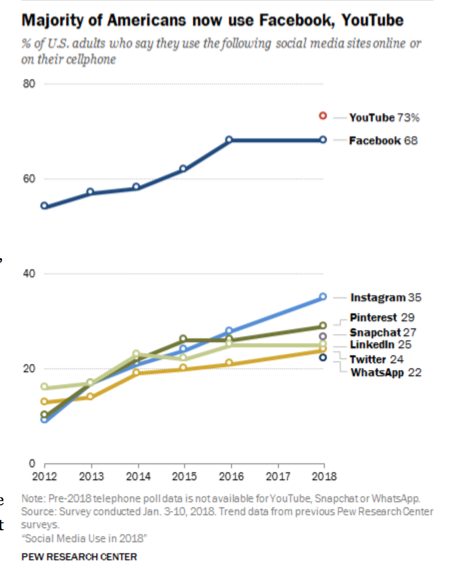
Despite negative press about data leaks like Cambridge Analytica and personal information privacy concerns, recent data revealed almost half of Facebook users haven’t changed their use of the social media network. Even more surprising, 26% of Facebook users have increased usage. (Ipsos, Thomson, Reuters, Statistica via Monday Note)
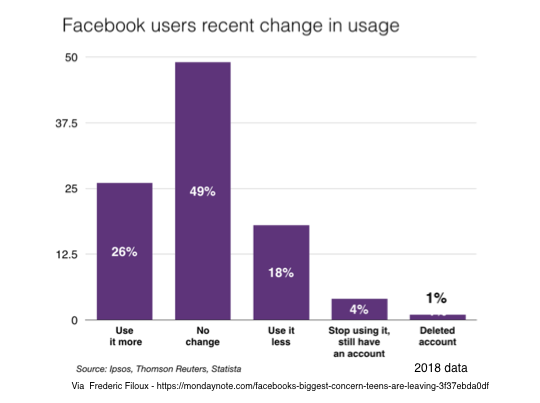
But don’t take these numbers at face value!
Because probing deeper discovered that US Facebook users share less content with with friends and followers. Even worse, 47% of Facebook users are concerned about their data privacy. (eMarketer 2018)
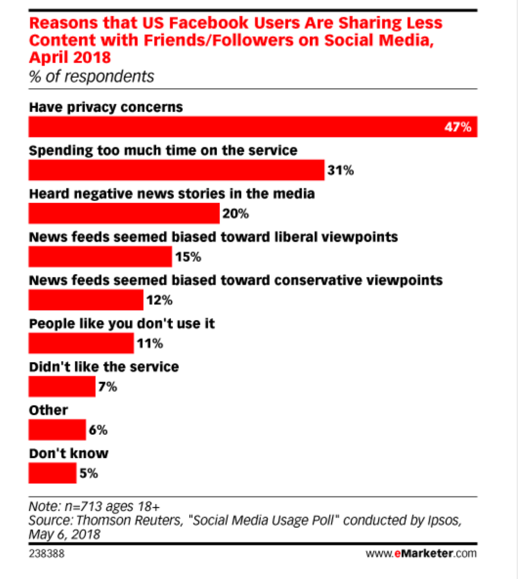
But of significant importance – while Facebook was once the social media home base of college students and teens, now young people are abandoning the platform for other social media sites.
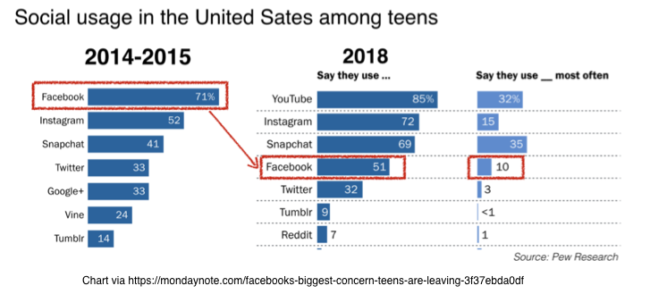
Further, from a demographic perspective Facebook has become less affluent and less educated.
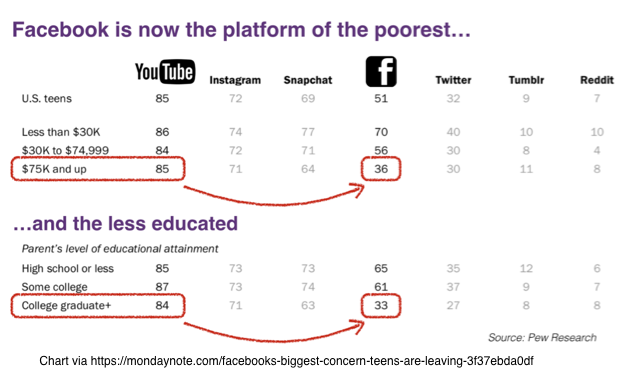
HOW PEOPLE ARE NOW USING SOCIAL MEDIA IN 2018
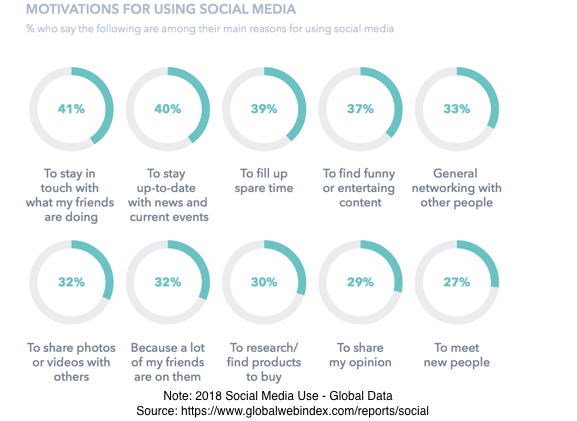
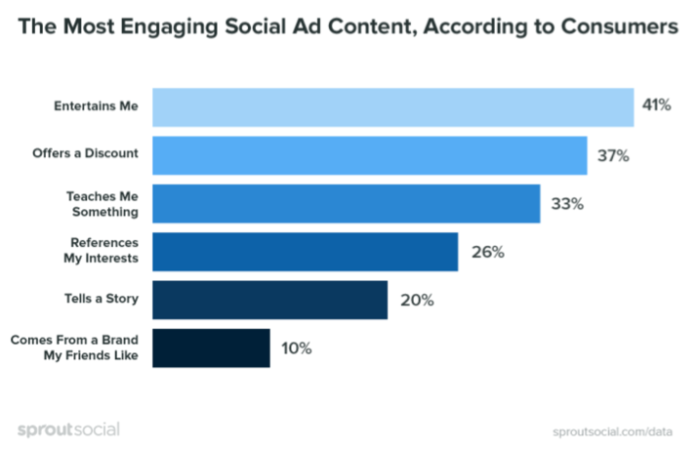
- 32% of global respondents use social media to share videos and photos. Offer videos and photos to improve your chances of being consumed. Again Sprout Social’s research shows consistent patterns.
- 30% of global respondents use social media to research products. Almost 40% of Internet users follow their favorite brands on social media and 1 in 4 follows brands they consider buying from. According to Mary Meeker, social media commerce increased to 6% in 2017.
MESSAGING APPS CONTINUE TO GROW
31% of inbound research respondents wanted to communicate with firms via messaging apps. Notably messaging apps use including Facebook continue to grow.
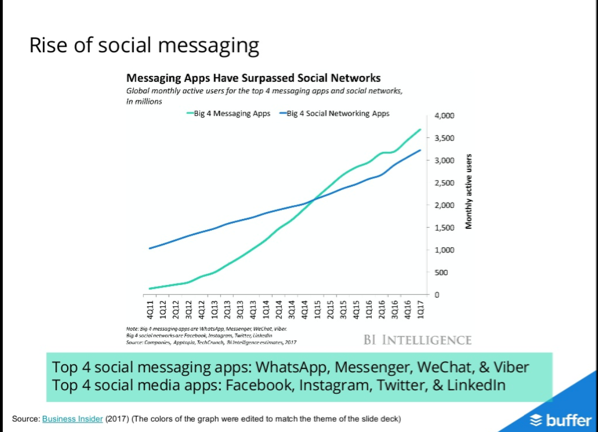
MEASURING ROI IS TOUGH
Of the marketers surveyed in Social Media Examiner’s report, only 10 percent felt they could effectively measure return on investment (ROI) for social media activities. Others felt they could somewhat measure ROI. Without a firm understanding of which social media activities successfully translate into sales, it can be a real challenge to know which campaigns to repeat and which ones to ditch.
What It Means: Figuring out ways to better track ROI for specific social media marketing campaigns is key. Create separate landing pages to learn which visitors convert into customers, and get a better measure of how well ads on social media work.
SOCIAL MEDIA CONSUMER SENTIMENT
At a minimum, you must expand social media use beyond content distribution and advertising to enter the purchase consideration set and to remain competitive among buying options.
To this end, get employees across your organization involved and active on social media to provide useful content, engage with and build relationships. Because your prospects, customers, peers and influencers spend time on social media.
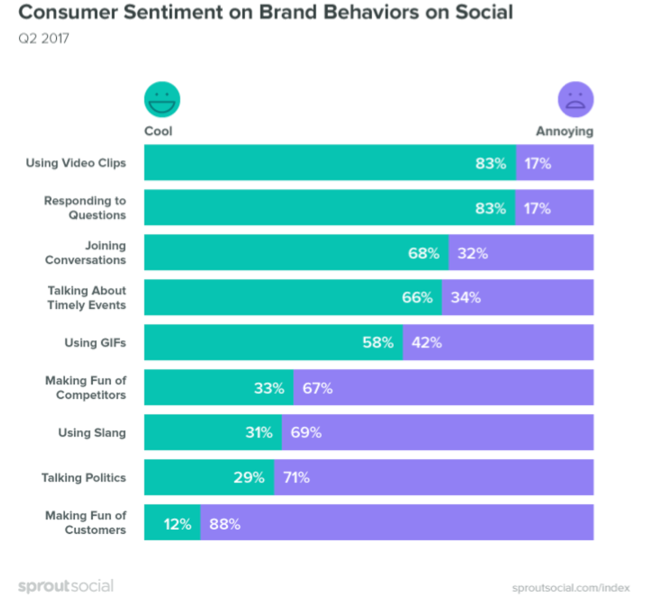
ADVERTISING ON FACEBOOK IS A MUST
Marketers shared that, in addition to organic activities, they’re also taking out paid ads on Facebook. Around 72 percent of marketers used Facebook for paid social media advertising, while only 31 percent used the second-place choice, Instagram.
What It Means: Split your advertising budget by shifting more focus to Facebook. If you have $100 to spend, invest at least half on Facebook advertising, and spread the rest to other outlets as needed.
SNAPCHATTING ISN’T GAINING MOMEMTUM
Snapchat still isn’t very popular in marketing circles, likely because Snapchat content is fleeting in nature. Only six percent of marketers indicated they’d increased Snapchat promotions in the last year, and only 16 percent said they had any plans for increasing Snapchat marketing. Snapchat may be an effective way to reach younger generations, but Instagram also targets a similar audience without the inconvenience of one-off posts that disappear quickly.
FINAL THOUGHTS
Your 2018 social media usage must move beyond content distribution and promotion to include customer service, sales, and community building.
The best way to accomplish this is to deliver the content your audience actively seeks on social media even before you know that they’re in-market for your products and services. At the same time, be available to engage with them and answer their questions.
The face of social media marketing changes quickly, but Facebook remains a vital player year after year. Regardless of where you focus your social marketing, learn who your audience is and where best to reach them, then factor in statistics about which platforms work best to draw in new leads.
By combining this information, your social media marketing is certain to succeed.
About Blair

Blair Evan Ball is a Social Media Coach and founder of Prepare1, a company that works with businesses, individuals and non-profits. He is a former executive with a Fortune 50 company, and his national division did $1Billion+ in sales annually.
Blair has written three e-books: Facebook for Business Made Easy, Facebook Pages for Business Made Easy, and WordPress Blog Setup Made Easy.
Blair also educates, trains entrepreneurs and business professionals how to amplify their brand, increase revenues, and raise more funds.
![[Study] How Will Businesses Change Their Social Media Activities 5 Golden Rules for Sharing on Social Media](https://www.prepare1.com/wp-content/uploads/2014/03/COACH-logohat-162x300.jpg) The Race is ON! | PREPARE | Get into the Game and WIN!
The Race is ON! | PREPARE | Get into the Game and WIN!




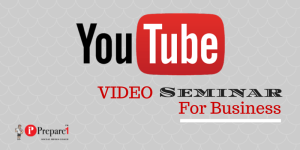





Comments on this entry are closed.